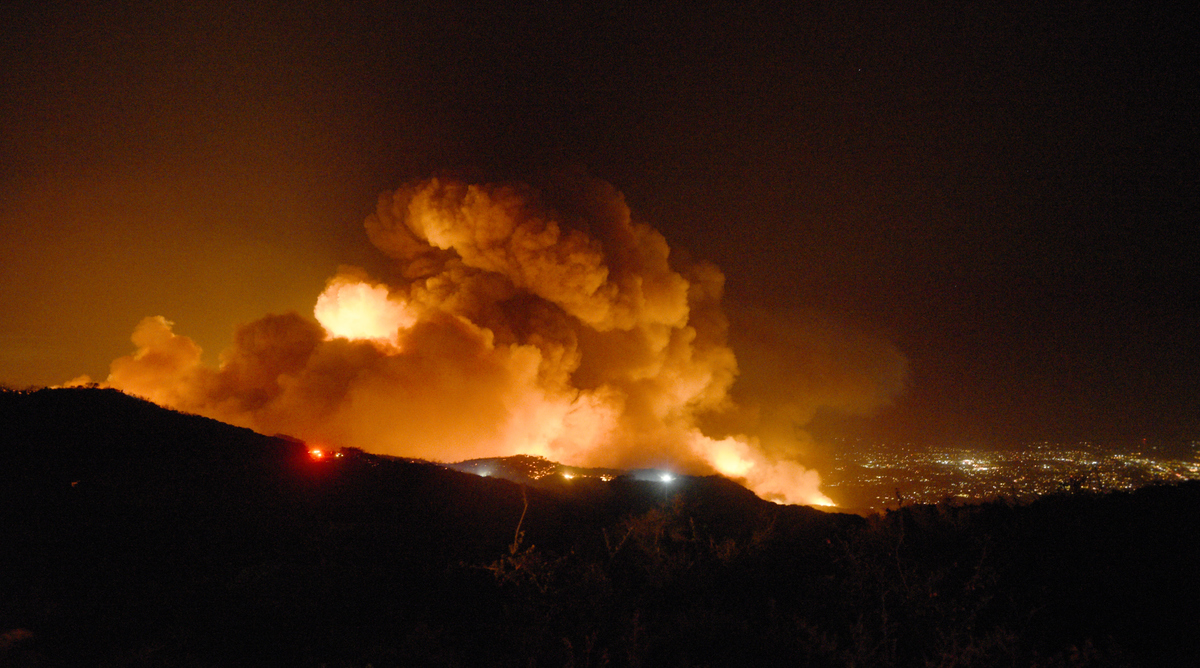Santa Barbara’s Cave Fire Tuesday Update
No Homes Destroyed as of Tuesday Afternoon

Santa Barbara finds itself forced to go into the holiday season much the way it did two years ago. Yet another fire is rampaging along the urban-rural interface where thick, sprawling strands of highly flammable chaparral stand six feet high. This time, the fire started on the urban side of the mountains, and intense night winds pushed the flames downslope to within a mile of Cathedral Oaks Road. A fire that started at 15 acres at 4 p.m. quickly expanded to 100, then 500, then 3,300 acres by 9 p.m. At dawn’s early light Tuesday morning, it was 4,100 acres. Fire commanders expect it will grow to at least 5,000 acres by the end of day two.
As of this writing, Tuesday, November 26, the Cave Fire, which originated at the intersection of Camino Cielo and San Marcos Pass roads, is officially uncontained. The cause of the fire remains unknown, but there’s no indication that arson was involved. To date, only one structure — described in official reports as an “out structure” — has been damaged or destroyed. That, however, can change with a gust of the wind.
Fifteen thousand homes are at risk as law enforcement agencies have found themselves yet again knocking on doors to be sure residents have evacuated. Sheriff Bill Brown said the total population living in the mandatory evacuation box was 5,484. Of the 2,284 residences contacted Monday, he said, 517 had evacuated, 324 did not, and 1,357 did not answer their phones. Fire Chief Mark Hartwig stressed: “If you see fire and smell smoke, don’t wait to be told.”
Firefighters have been focused on structure protection rather than perimeter control. That explains the zero percent containment numbers. Typically, five engines will be dispatched to a neighborhood with each engine assigned responsibility for five structures. Crews clear brush and debris near homes that need it; if there’s a lot of stuff, they’ll move on to what they see as a more protectable property. Hartwig singled out the community of Painted Cave, which until this year maintained a crackerjack volunteer fire department that did a great job clearing brush and creating defensible space.
As of Tuesday, five helicopters are dropping water on hot spots; five S2 fixed-wing planes and large DC-10s, known in the jargon as a VLAT, short for Very Large Air Tanker, will be dumping retardant. A spotter plane is helping coordinate air operations. The Red Cross is operating emergency shelters out of the Goleta Community Center, and the Earl Warren Showgrounds has once again opened its doors to the South Coast’s horses and other large critters.
As hundreds of firefighters — 600 at last counting but sure to increase — attack the Cave Fire, the rest of Santa Barbara waits to see which way the winds will blow. Monday night, winds came howling down the mountain at about 40 miles per hour, pushing the spotting embers downslope. By midnight, that wind had died down to 10 miles per hour. Hartwig, still relatively new to Santa Barbara, said he’s been struck by the multitude of microclimates from canyon to canyon. The wind patterns, he said, are among the most complex in the state.
The supervisors signed an emergency declaration that will help Santa Barbara draw the resources necessary, especially since there are no major fires blowing throughout the state. As crucial as this help is, Santa Barbara remains at very much at the mercy of its weather patterns. The good news is that Tuesday should be cool, and rains are expected to begin falling by midnight. By the end of the week, it could be by as much as four inches. This, of course, raises the specter of flooding and mudslides, though the prospect of anything comparable to the debris flow of two years ago is extremely slim. Rarely has “bad” weather been so eagerly welcomed.



